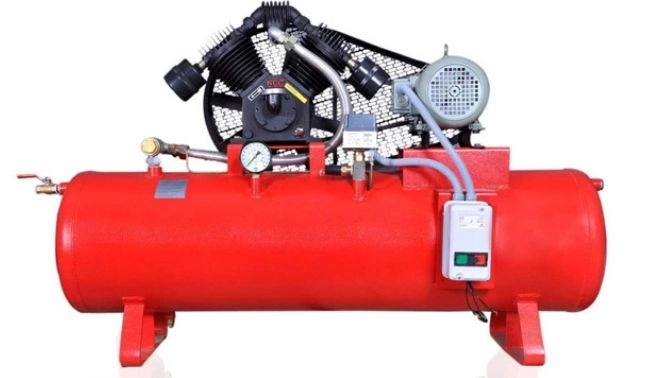کمپرسورهای پیستونی
Reciprocating compressors, or reciprocating compressors, rely on the reciprocating action of one or more pistons to compress gas within a cylinder (or cylinders) and discharge it through a valve into high-pressure receivers. In many cases, the tank and compressor are installed as a packaged unit in a common frame. While the primary use of reciprocating compressors is to provide compressed air as an energy source, reciprocating compressors are also used by pipeline operators to transport natural gas. Reciprocating compressors are usually selected based on required pressure (psi) and flow rate (scfm). A typical plant air system provides compressed air in the 90-110 psi range, with volumes ranging from 30 to 2500 cfm. These ranges are generally available through commercial and off-the-shelf units. Plant air systems can be sized around a single unit or can be based on several smaller units located throughout the plant. Two-stage units are available to achieve higher air pressure than can be provided by a single-stage compressor. Compressed air entering the second stage is usually pre-cooled by an intercooler to remove some of the heat generated in the first stage. When it comes to heat, many reciprocating compressors are designed to operate on a single duty cycle rather than continuously. Such cycles allow the heat generated during operation to dissipate, in many cases through air-cooled vanes. Reciprocating compressors are available in both oil-lubricated and oil-free versions. For some applications that require the highest quality oil-free air, other designs are more suitable.

نحوه عملکرد کمپرسور رفت و برگشتی
As the piston retracts, gas is drawn into the cylinder through the inlet valve (or valves), and when the piston returns, the gas is forced out through the exhaust valve. The pistons are moved by a crankshaft, which can be driven by an electric motor, a gasoline engine, or any other suitable rotary power source. Cylinders are often paired on either side of the crankshaft so that the pistons move against each other.
Reciprocating compressors have many applications in industries including natural gas processing and delivery, chemical plants, and oil refineries. Compressed gases also play a major role in refrigeration technology, where the re-expansion of the gas after compression provides the required cooling effect. Many compressed air applications use reciprocating compressors in diverse environments such as diving, dental surgeries, automotive workshops, and agriculture. Pneumatic (air-powered) tools, such as drills and angle grinders, are important in industry because they are generally lighter and safer than electrically powered tools.
بهره وری کمپرسور پیستونی
Reciprocating compressors are considered the most energy efficient type of compressor for most applications except those involving small amounts of gas. However, they tend to require more maintenance than other types of compressors, so cost calculations must balance energy versus maintenance costs. A major maintenance problem is the need to prevent gas leakage from the piston head, which means that piston rings must be replaced regularly.
کمپرسورهای پیستونی مایع یونی
In this new type of reciprocating compressor, the piston that compresses the gas is made not of metal, but of ionic liquid, a type of liquid salt that is used in Compression technology owes much to the recent work of British scientists. The liquid piston greatly reduces the need for seals and bearings and dramatically improves compressor efficiency. This technology is particularly effective in dealing with highly volatile gases such as hydrogen and is likely to become increasingly important in the future.
A reciprocating air compressor works on the principle of positive displacement – it increases air pressure by decreasing volume. These devices receive successive volumes of air in a closed space and increase the pressure of this air significantly.
کاربرد و گزینه های کمپرسور هوای رفت و برگشتی
A reciprocating air compressor works on the principle of positive displacement – it increases air pressure by decreasing volume. These devices receive successive volumes of air in a closed space and increase the pressure of this air significantly. This is done by the action of the piston inside the cylinder as a compression and displacement device. At Havapaya, we offer innovative compressor technology as a result of high quality design and manufacturing processes.
کاربردهای کمپرسورهای هوای رفت و برگشتی
Reciprocating compressors are designed to be used intermittently and when a small amount of air is needed. They are perfect for small businesses and construction jobs, workshops, homeowners and do-it-yourself projects. Using a reciprocating air compressor may be the optimal choice over a rotary compressor if your compressor is likely to be idle about 33% of the time. Rotary compressors may not work well after long periods of operation.
تک و دو نقشی
Single-stage and two-stage reciprocating compressors are available in the commercial market. Single-stage compressors are often used for outlet pressures between 70 psig and 100 psig. Two-stage compressors are often used with higher pressures between 100 psig and 250 psig.
It is important to note that 1 HP is equal to 4 CFM at 100 psi and reciprocating units typically handle 1 to 50 HP. Rotary screw and centrifugal compressors typically operate at 100 horsepower and above.
A single-stage reciprocating air compressor performs compression using only one side of the piston. A two-stage compressor uses two sides of the piston.
Load reduction is achieved by emptying individual cylinders. This is usually done by the process of bypassing air (outside or inside the compressor) or reducing the suction pressure. Capacity control is obtained by changing the speed of the drive motor compressors through fuel flow control.

